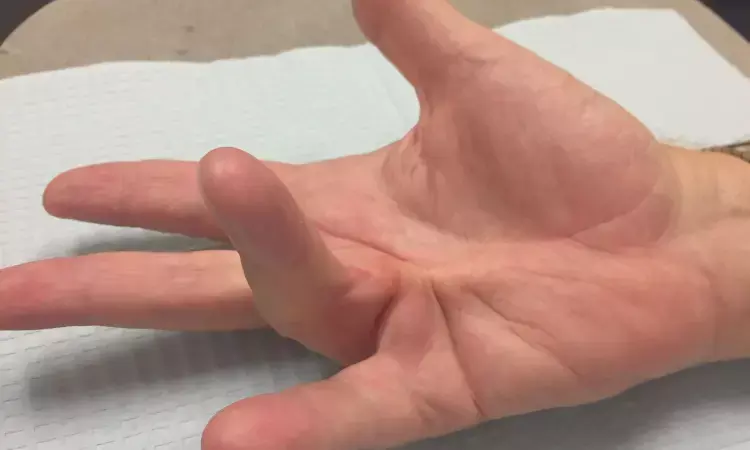- Home
- Medical news & Guidelines
- Anesthesiology
- Cardiology and CTVS
- Critical Care
- Dentistry
- Dermatology
- Diabetes and Endocrinology
- ENT
- Gastroenterology
- Medicine
- Nephrology
- Neurology
- Obstretics-Gynaecology
- Oncology
- Ophthalmology
- Orthopaedics
- Pediatrics-Neonatology
- Psychiatry
- Pulmonology
- Radiology
- Surgery
- Urology
- Laboratory Medicine
- Diet
- Nursing
- Paramedical
- Physiotherapy
- Health news
- Fact Check
- Bone Health Fact Check
- Brain Health Fact Check
- Cancer Related Fact Check
- Child Care Fact Check
- Dental and oral health fact check
- Diabetes and metabolic health fact check
- Diet and Nutrition Fact Check
- Eye and ENT Care Fact Check
- Fitness fact check
- Gut health fact check
- Heart health fact check
- Kidney health fact check
- Medical education fact check
- Men's health fact check
- Respiratory fact check
- Skin and hair care fact check
- Vaccine and Immunization fact check
- Women's health fact check
- AYUSH
- State News
- Andaman and Nicobar Islands
- Andhra Pradesh
- Arunachal Pradesh
- Assam
- Bihar
- Chandigarh
- Chattisgarh
- Dadra and Nagar Haveli
- Daman and Diu
- Delhi
- Goa
- Gujarat
- Haryana
- Himachal Pradesh
- Jammu & Kashmir
- Jharkhand
- Karnataka
- Kerala
- Ladakh
- Lakshadweep
- Madhya Pradesh
- Maharashtra
- Manipur
- Meghalaya
- Mizoram
- Nagaland
- Odisha
- Puducherry
- Punjab
- Rajasthan
- Sikkim
- Tamil Nadu
- Telangana
- Tripura
- Uttar Pradesh
- Uttrakhand
- West Bengal
- Medical Education
- Industry
Dupuytren's Disease or Its Mimicker? Study Sheds Light on The Importance of Careful Diagnosis

UK: A new study published in Apollo Medicine by researchers from the Royal Orthopaedic Hospital in Birmingham, UK, highlights that a variety of benign and malignant palmar lesions can closely resemble Dupuytren’s disease, presenting potential diagnostic pitfalls for clinicians. The findings from a 12-year observational review underline the importance of combining clinical judgment with imaging and histopathological tools to achieve an accurate diagnosis.
Dupuytren’s contracture is a progressive fibroproliferative disorder of the palmar fascia that can result in significant hand deformities, limiting daily activities such as gripping, washing, and cleaning. Often termed “Viking disease” due to its prevalence among individuals of Northern European descent, it remains relatively uncommon among Asian and African populations. Risk factors include male gender, family history, smoking, alcohol use, diabetes mellitus, epilepsy, and chronic pulmonary disease, among others.
Commenting on the study, lead author Dr. Rajesh Botchu, Department of Musculoskeletal Radiology at Royal Orthopaedic Hospital, told Medical Dialogues,
"Dupuytren’s disease can mimic a range of other neoplastic and non-neoplastic conditions affecting the palm, which sometimes creates a diagnostic conundrum. Our study emphasises the value of a good clinical history, focused examination, and, where needed, advanced imaging and histopathology to differentiate true cases of Dupuytren’s disease from mimickers."
The team conducted a retrospective analysis of palmar lesions referred to their tertiary orthopaedic oncology centre between 2008 and 2020. The review focused specifically on lesions located within the palmar aponeurosis, excluding thenar and hypothenar regions. The analysis included clinical records, imaging, and histopathology. The following key findings were reported:
- 21 palmar lesions were identified in total.
- The average patient age was 48 years (range: 3–69 years).
- Gender distribution was nearly equal: 11 females and 10 males.
- 16 lesions were benign tumours; 1 case was malignant rhabdomyosarcoma.
- Lipomas were the most common benign tumour (5 cases).
- Other benign tumours included neurofibromas (3), schwannoma (1), granuloma (1), ganglion cyst (1), giant cell tumour (1), angiomyxoma (1), myofibroma (1), cavernous haemangioma (1), and non-specific fibrovascular lesion (1).
- Four additional non-neoplastic lesions were also recorded.
According to Dr. Botchu,
"While a detailed clinical history and focused examination can often lead to a diagnosis of Dupuytren’s contracture, clinicians should remain alert to atypical presentations. Some palmar lesions that mimic Dupuytren’s may require histopathological confirmation, particularly when clinical features do not fit the classic pattern."
The findings have important implications for improving diagnostic accuracy. Many early-stage mimickers could be misinterpreted as Dupuytren’s disease, potentially resulting in incorrect or delayed management. A careful combination of history, examination, imaging, and pathology remains key to achieving diagnostic certainty.
Looking to the future, Dr. Botchu stressed the importance of advancing diagnostic strategies:
"Greater awareness among clinicians and the use of high-resolution ultrasound and elastography may enhance early detection of these conditions. In addition, further genetic and molecular studies may improve understanding of Dupuytren’s disease itself, including its association with metabolic syndrome, which still requires deeper investigation."
"Ultimately, the study calls for heightened vigilance among clinicians when evaluating palmar lesions and reinforces the importance of multidisciplinary approaches to ensure accurate diagnosis and effective management," he concluded.
Reference:
Saad, A., Perumandla, M. R., Arbuthnot, C., Iyengar, K. P., & Botchu, R. Lesions of the Palm – Mimickers of Dupuytren’s Disease. Apollo Medicine. https://doi.org/10.1177/09760016241288945
Dr Kamal Kant Kohli-MBBS, DTCD- a chest specialist with more than 30 years of practice and a flair for writing clinical articles, Dr Kamal Kant Kohli joined Medical Dialogues as a Chief Editor of Medical News. Besides writing articles, as an editor, he proofreads and verifies all the medical content published on Medical Dialogues including those coming from journals, studies,medical conferences,guidelines etc. Email: drkohli@medicaldialogues.in. Contact no. 011-43720751


